I love trees. I love listening to the rustling of the leaves as the wind blows through them. I love the way sunlight gleams through the branches as you look up into the canopy. I love watching birds chirp down at me from above and seeing the amazing grip that squirrels use to dart up a tree trunk. I love the different textures of bark and the way insects climb trunks like they are on a little pedestrian highway. And I love the green, green leaves of trees and the way the veins and shapes make each leaf unique. But of all trees, at least those in Texas, I have a very favorite one. Meet Anacua, or Ehretia anacua.
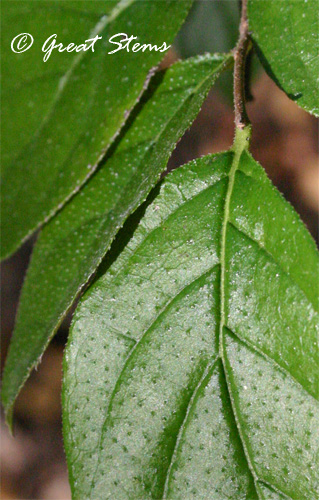 Anacua has another name. It’s often called Sandpaper Tree, because the leaves of this gorgeous plant are very, very rough. It’s actually a very pleasing roughness, if that makes sense — those who are tactile-oriented will know what I mean. This plant is FUN to touch. You can see the little bumps on the leaves that contribute to the sandpaper-feel.
Anacua has another name. It’s often called Sandpaper Tree, because the leaves of this gorgeous plant are very, very rough. It’s actually a very pleasing roughness, if that makes sense — those who are tactile-oriented will know what I mean. This plant is FUN to touch. You can see the little bumps on the leaves that contribute to the sandpaper-feel.
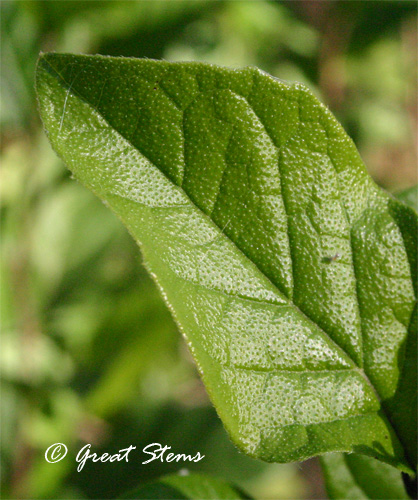 Anacua is native to Mexico and Texas, and its northern range is central Texas. Farther north, the tree freezes back in the winter. But if you ever have a chance to come visit this area, seek out an Anacua — it is so worth it just to touch the leaves. That’s how much I love this plant. In the meantime, go get a bit of medium-grit sandpaper, close your eyes, and give it a rub — that’s pretty close to how these leaves feel.
Anacua is native to Mexico and Texas, and its northern range is central Texas. Farther north, the tree freezes back in the winter. But if you ever have a chance to come visit this area, seek out an Anacua — it is so worth it just to touch the leaves. That’s how much I love this plant. In the meantime, go get a bit of medium-grit sandpaper, close your eyes, and give it a rub — that’s pretty close to how these leaves feel.
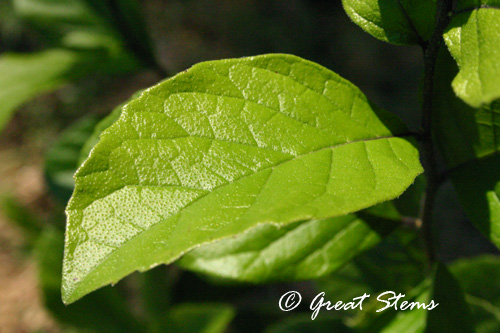 My trees (I have two now) are only about 3-4 feet high, so it will be awhile before I can show them at full size, up to 50 feet tall. But the leaf color is gorgeous. The tree is considered semi-evergreen, replacing its leaves briefly in the spring. During the year it will produce white flowers that are a bee favorite, and later it will produce orange-colored berry-like fruit that birds enjoy. In fact, the berries are the reason the tree has yet another common name, Sugarberry. Right now my trees are at least resting spots for butterflies like this Silver-Spotted Skipper.
My trees (I have two now) are only about 3-4 feet high, so it will be awhile before I can show them at full size, up to 50 feet tall. But the leaf color is gorgeous. The tree is considered semi-evergreen, replacing its leaves briefly in the spring. During the year it will produce white flowers that are a bee favorite, and later it will produce orange-colored berry-like fruit that birds enjoy. In fact, the berries are the reason the tree has yet another common name, Sugarberry. Right now my trees are at least resting spots for butterflies like this Silver-Spotted Skipper.
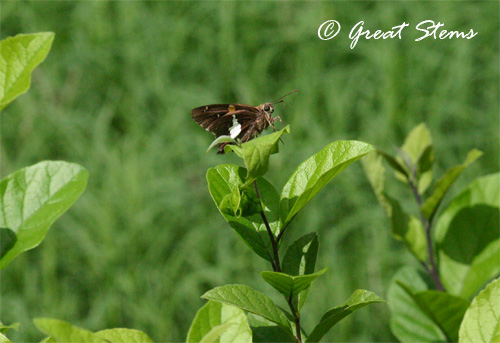
Anacuas thrive in limestone soil, by the way. Good thing I have plenty of that! Grow, little trees, grow!
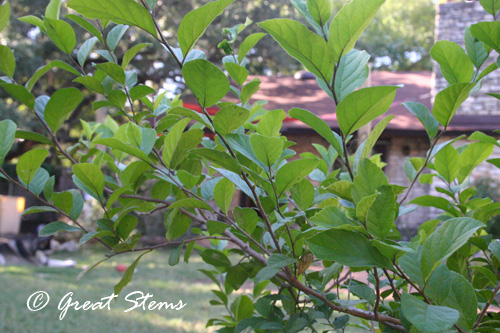 What’s your favorite tree?
What’s your favorite tree?
Meredith,
This one is entirely new to me. Next time I’m down in TX I’ll know what to look for. My favorite tree in Flowering Dogwood, they are full of red berries right now waiting for the thrushes to feast on them.
Those are so beautiful — I don’t think I’ve ever seen the berries, though! Yay for happy birdies.
Thanks for the introduction to this unusual tree. I’d never heard of it before your post – very interesting! One of my favorites – too hard to narrow down to a single favorite – is the anacacho orchid tree. It has the sweetest, delicate white flowers in the spring. I just planted a volunteer from a friend’s tree yesterday. I’m looking forward to watching it grow into a tree from a seedling.
I have never heard of this tree. I will look out for it in the future.
Cat, I love Anacacho Orchid, too. It’s so pretty when it blooms — the Mexican variety is a sweet version, too.
What beautiful foliage — I did want to reach out to the computer and touch it! I’m with Cat on the Anacacho Orchid. I lost one last year, but am going to relace it this fall. I also love my giant Burr Oak. It’s not a pretty little understory tree, but I am in awe of it’s grandeur.
Never seen nor heard of such a tree, but the leaves are beautiful and I’m quiite sure, one that I would enjoy. I’ve recently fallen in love with the Oklahoma Rebud, similar to the Eastern Redbud but much better suited for our hot summer days.
Diana and Meredehuit, you have both listed two other favorites of mine. Bur Oak is incredibly majestic — I’ve wanted one for so long. And I adore Mexican Redbud, which is a smaller, drought-hardy native redbud perfect for Central Texas.
Sometimes I just can’t pick out a favorite and this is one of those times. In fact, I doubt I could pick out a favorite plant either. I almost like all of them. Your sandpaper tree is a new one on me. Do they grow commonly around town? I wonder if I have seen them but just never noticed them. I shall be feeling leaves next time I go out.
If I were to guess, I bet there might be one at the Wildflower Center. I know they have one at a middle school down south. I’ll start keeping my eye out for others — I know I’ve seen more, but I’m blanking on them, I’m so worn out tonight. But I learned about them somewhere! I think I’ve seen them for sale at Natural Gardener, too… maybe. But I know they sell out at the WFC sales.
Flowering Senna or Yaupon Holly for me.
Hey, I love these trees, too! Anacua will grow into full sized trees, although very slowly. In my back yard is a medium sized Anacua, about twenty feet tall, a native. I live a few hundred feet from Panther Canyon, just above Comal Springs in New Braunfels, Texas. In the canyon there are sandpaper trees that are as large as oaks, and are surprisingly similar in appearance to oaks – leaves very dark, bark very knurled. With a mature Anacua, the trunk is often several trunks that have fused together. They also seem to send out runners that may have offshoot trees. My understanding is that the Sandpaper tree was locally known by the German settlers as “Voglebeerenbaum” (my spelling is no doubt off), which means “beer berry tree”.
That’s fantastic, Kent! I’m going to have to come down to visit the Anacuas in New Braunfels (I graduated from Canyon HS down there) — I’d love to see those big trees. I hope they’ve handled this year’s freezes okay. Very interesting info about the local German history, too — thank you so much for sharing!
Hi Meredith,
I very much wanted to plant an Anacua Sugarberry, but was discouraged because of its potential freeze sensitivity. What part of Austin do you live in? I’m in Round Rock, which is north so possibly a bit colder……
Also, I saw a tree called “Anacuahita” at the nursery next to Whittlesey’s off I-35 up by La Frontera. I don’t know enough to be able to say if this was an Ehretia anacua; would you possibly know?
Thank you!
Kathy
Hi, Kathy. I think Anacuahita refers to Mexican Olive, not the Sandpaper Tree Anacua. I actually live in North Austin (we are in the Round Rock school district), so I think you can probably safely give Anacua a try, especially with climate change going on. In the worst of freezes, the tree might temporarily drop its leaves. Mine did the first year when it snowed a little but they leafed out again no problem — this past year with the mild temperatures, they were green the whole time. I hope that helps! You might look for Anacua at the Wildflower Center sale this April — they have had it there in the past. Good luck!
Pingback: When My Baby Trees Are All Grown Up | Great Stems
Hi Merideth. I’m trying to update my database with pollination requirements, and wondered if you know if Anacua flowers are bisexual or monoecious. I can’t seem to find that information anywhere.
Hi, Mitch. That’s a great question. I wondered the same as I wrote the posts about Anacua, but I also haven’t found the answer. My own trees haven’t bloomed yet (and I expect one to bloom before the other one will), so I can’t report successful (or non-successful) drupes.
Thanks for the wonderful description!! These have quickly become my favorite decorative tree as I have been spotting them all over the area of San Antonio, growing wild. In fact, I spotted one growing in my backyard and it must have just sprouted up from some seeds a bird dropped. We have not noticed them before this one started in my backyard.
They seem to grow very quickly. We now have two of them in our yard and they are both over 7 feet in just 2 years. Any idea on how fast they can grow and when we should prune them to get an appealing look to them? I don’t want the lower branches on the tree as I like a nice canopy that is at least 6 to 7 feet above the ground.
They do seem to grow reasonably fast, which I certainly appreciate as I always start with very small trees in my yard. It’s good that you’ve waited to prune until the tree is over 2 years old — it’s better for the tree. I also plan some of the lower branches this winter.
Hi Meredith! I just wanted to let you know that my nursery – River Road Nursery in New Braunfels is growing Anacuas! Like mountain laurels, they are expensive and rare in nurseries because they grow so slowly. Right now we have babies about 2 feet tall in 3 gallon pots for $15. They were grown from seed from a native on the property. We also have 3100 other native or naturalized trees that are perfect for our Hill Country area. Your readers can call (830) 660-8872 if they would like their very own.
Great to know, Carlyn. I’ll try to visit your nursery when I’m next in town. I occasionally give talks in the area and it will be nice to know more about the local nurseries.
Grew up under an anacua in Brownsville . The musky smell and taste of its fruit you’ll not forget. Rarer than the guava trees down from it.. Got tricked into putting a anacua leaf on my tongue. I almost choked from its raspy lock and easy to extract. Mean trick, but the memories of sitting beneath it are some of the first. At night the light shone through the screen door with the sounds of the folks catching up with each other inside as the young uns cut up outside beneath the anacua.
Correction: Not easy, to extract.
What a nice memory of a tree, JFlash — well, not the almost-choking part. I hope we’ll have such memories when these Anacuas get tall.